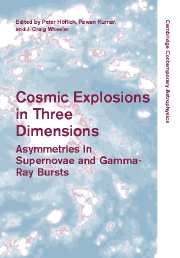Book contents
- Frontmatter
- Contents
- Part I Introduction
- Part II Supernovae: Observations Today
- Part III Theory of Thermonuclear Supernovae
- 10 Semi-Steady burning evolutionary sequences for CAL 83 and CAL 87: Super Soft X-ray binaries are supernova Ia progenitors
- 11 Type Ia progenitors: effects of spin-up of white dwarfs
- 12 Terrestrial combustion: feedback to the stars
- 13 Non-spherical delayed detonations
- 14 Numerical simulations of Type Ia supernovae: deflagrations and detonations
- 15 Type Ia supernovae: spectroscopic surprises
- 16 Aspherity effects in supernovae
- 17 Broad lightcurve SNe Ia: asymmetry or something else?
- 18 Synthetic spectrum methods for three-dimensional supernova models
- 19 A hole in Ia? Spectroscopic and polarimetric signatures of SN Ia asymmetry due to a companion star
- 20 Hunting for the signatures of 3-D explosions with 1-D synthetic spectra
- 21 On variations in the peak luminosities of Type Ia supernovae
- Part IV Theory of Core Collapse Supernovae
- Part V Magnetars, N-Stars, Pulsars
- Part VI Gamma-ray Bursts
- Part VII Conference Summary
- References
20 - Hunting for the signatures of 3-D explosions with 1-D synthetic spectra
Published online by Cambridge University Press: 11 August 2009
- Frontmatter
- Contents
- Part I Introduction
- Part II Supernovae: Observations Today
- Part III Theory of Thermonuclear Supernovae
- 10 Semi-Steady burning evolutionary sequences for CAL 83 and CAL 87: Super Soft X-ray binaries are supernova Ia progenitors
- 11 Type Ia progenitors: effects of spin-up of white dwarfs
- 12 Terrestrial combustion: feedback to the stars
- 13 Non-spherical delayed detonations
- 14 Numerical simulations of Type Ia supernovae: deflagrations and detonations
- 15 Type Ia supernovae: spectroscopic surprises
- 16 Aspherity effects in supernovae
- 17 Broad lightcurve SNe Ia: asymmetry or something else?
- 18 Synthetic spectrum methods for three-dimensional supernova models
- 19 A hole in Ia? Spectroscopic and polarimetric signatures of SN Ia asymmetry due to a companion star
- 20 Hunting for the signatures of 3-D explosions with 1-D synthetic spectra
- 21 On variations in the peak luminosities of Type Ia supernovae
- Part IV Theory of Core Collapse Supernovae
- Part V Magnetars, N-Stars, Pulsars
- Part VI Gamma-ray Bursts
- Part VII Conference Summary
- References
Summary
Abstract
Multi-dimensional models of supernovae show radial and non-radial variation in the density and composition not seen in one-dimensional models. Many of the questions about the flow of radiation through the expanding, multi-dimensional atmosphere will require multi-dimensional radiation transport calculations, but some may be tested with existing one-dimensional transport codes. So far, tests with models of Type Ia supernovae have shown that the unburned fuel (C+O) mixed down into deeper layers in multi-dimensional models have only a simple (C II lines) and modest signature in the spectra. This places only light constraints on the mixing of C+O into the lower layers of Type Ia supernovae.
3-D effects on supernova spectra
The proliferation of multi-dimensional explosion models for supernovae has made it clear that using one dimensional models for spectrum synthesis is not fully adequate. How adequate are the old 1-D spectral models? What are the multidimensional signals present in the light received from distant supernovae? Can we calculate spectra with 1-D codes that can explore the multi-dimensional effects?
The clearest multi-dimensional signal in spectrum of supernova is polarization. The number of polarization observations of supernovae have increased dramatically in the last decade, and polarization has now been detected in all types and sub-types of supernovae. Since it is impossible to calculate polarization in the 1-D models we calculate, we will not discuss polarization further, but Kasen discusses polarization elsewhere in this volume.
- Type
- Chapter
- Information
- Cosmic Explosions in Three DimensionsAsymmetries in Supernovae and Gamma-Ray Bursts, pp. 173 - 178Publisher: Cambridge University PressPrint publication year: 2004



